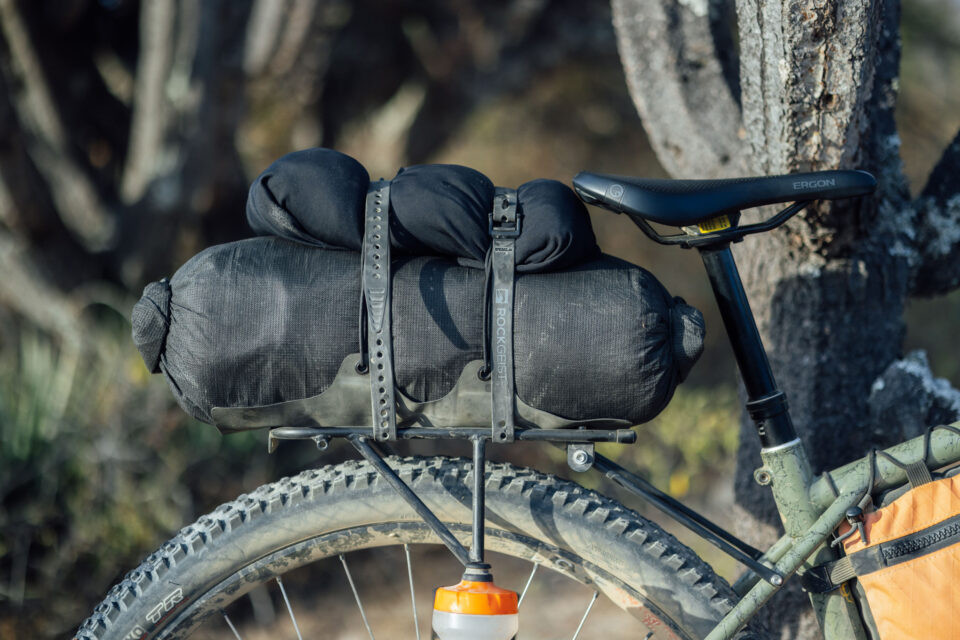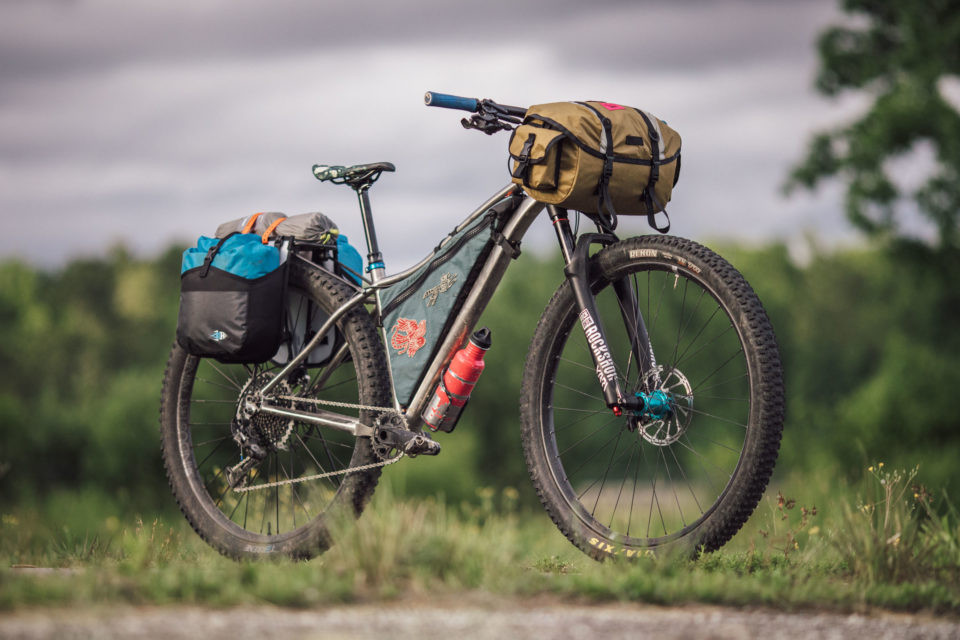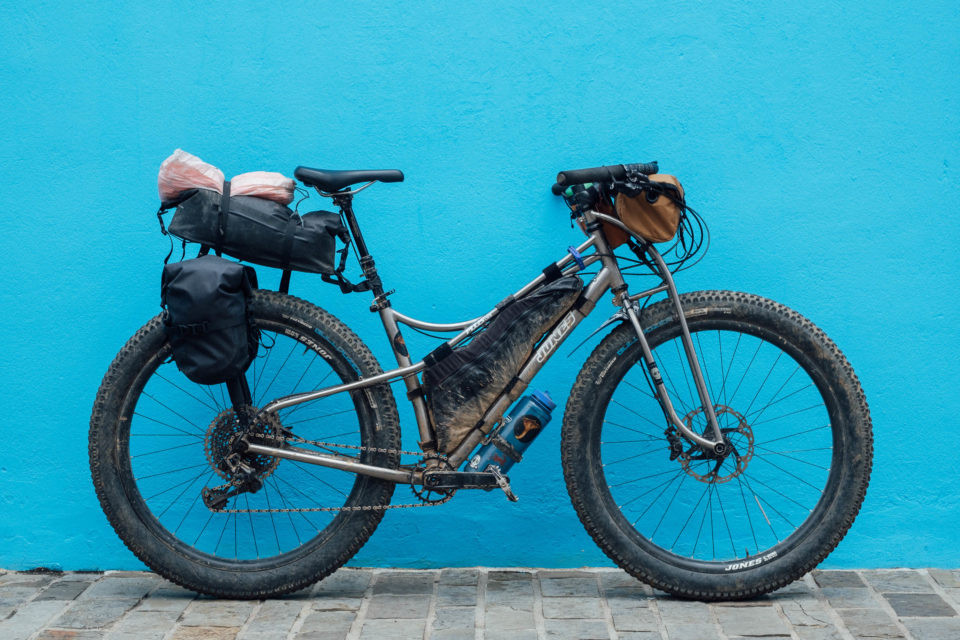For many cyclists venturing into bike travel, the journey often begins with a classic setup: a Rear Bike Carrier and panniers. This timeless combination remains a cornerstone of traditional bike touring, celebrated for its versatility and practicality. In today’s bikepacking scene, lightweight rear bike carriers are experiencing a resurgence, especially when paired with smaller, high-quality panniers. They offer an excellent solution for riders needing extra cargo space or for bikes where seat bag clearance is limited. Much like a reliable front rack, a lightweight rear bike carrier proves to be an invaluable accessory for bikepacking adventures, daily commutes, and errands around town.
Versatile Uses of a Rear Bike Carrier
While the applications are numerous, here are three primary ways a rear bike carrier enhances a bikepacking setup:
 Mini panniers attached to a rear bike carrier for bikepacking gear
Mini panniers attached to a rear bike carrier for bikepacking gear
Mini Panniers for Extra Capacity
Integrating mini panniers with either a front or rear bike carrier is an ideal strategy when you require additional packing volume. Some riders find a heavily loaded front end cumbersome, making a rear bike carrier a preferred choice. Furthermore, on challenging terrains, positioning the load at the rear enhances front-end agility, allowing for better control and visibility of the front wheel’s path.
 Dry bag strapped securely on top of a rear bike rack for bike touring
Dry bag strapped securely on top of a rear bike rack for bike touring
Dry Bags and Strapped Gear
Even when panniers aren’t necessary, rear bike carriers serve as a superb platform for carrying gear. This is particularly beneficial when using a long-travel dropper post for technical bikepacking. When a standard seat bag’s volume falls short, a dry bag strapped directly to the rear bike carrier platform becomes incredibly useful. This setup not only maintains full dropper post functionality but also offers easy packing and exceptional stability.
 Cargo cages mounted on a rear bike carrier for carrying water bottles during cycling trips
Cargo cages mounted on a rear bike carrier for carrying water bottles during cycling trips
Bottle and Cargo Cages for Added Gear
Certain rear bike carriers, such as the Tumbleweed T-Rack and OMM Elkhorn, are designed with threaded bosses that accommodate bottle and cargo cages, further expanding carrying capacity. This added versatility is a significant advantage, allowing riders to carry extra water or gear as needed. It’s also an excellent solution for cyclists who lack heel clearance for panniers but still require additional space for equipment.
Key Benefits of Using a Rear Bike Carrier
 Cyclist riding with a rear bike carrier setup on a scenic trail in Virginia
Cyclist riding with a rear bike carrier setup on a scenic trail in Virginia
Enhanced Clearance and Optimized Space
Limited space is a primary motivator for choosing a rear bike carrier. Smaller bike frames often restrict frame bag space, and limited clearance between the saddle and rear tire—or handlebar and front tire—reduces packing capacity, highlighting the need for a rear bike carrier setup. Saddle-to-tire clearance becomes even more critical for bikepackers using dropper posts. Often, even the smallest dropper-compatible seat bags can interfere with the tire. By relocating gear weight to a rear bike carrier, you ensure smooth dropper post operation, maximize travel, and lower the center of gravity for improved stability.
 Jones bike with a rear bike carrier system for long distance bikepacking adventures
Jones bike with a rear bike carrier system for long distance bikepacking adventures
Expandability for Varied Trip Lengths
Unlike most seat bags with fixed capacities, rear bike carriers offer adaptable versatility to suit different needs. For shorter excursions, simply strapping a dry bag to the platform provides a straightforward way to transport bulky items. When more space is necessary, adding a pair of small panniers significantly increases capacity. Racks equipped with threaded bosses are also ideal for carrying extra water, fuel, or gear on longer journeys, creating a highly expandable packing system.
Selecting the Right Rear Bike Carrier for Your Needs
Choosing the best rear bike carrier depends on several factors, primarily your intended use and gear. Compatibility with panniers varies among racks, and weight limits dictate suitability for dry bags or heavier loads. Consider if carrying extra water is a priority, especially for routes like the Baja Divide. In such cases, racks with cargo cage expandability, such as the Tumbleweed T Rack, Old Man Mountain Elkhorn, or Tailfin Aeropack system, are excellent choices.
Compatibility is crucial and often best assessed with help from a local bike shop or the rack manufacturer. However, here are essential specifications to consider and measure:
Tire Clearance for Optimal Performance
Tire clearance is paramount. While some manufacturers provide limited information, platform size can offer clues. Brands like Tubus sometimes provide schematic drawings. Ensure ample space to prevent rubbing and maintain smooth rides, especially with wider tires common in bikepacking.
Rack Height for Balanced Load
Rack height, the distance between the platform and lower mounting bolt hole, is another critical measurement. Mounting points on bike frames vary, so measure the vertical space between your lower mount and tire top. Ideally, allow a couple of centimeters for mud clearance and ensure the platform isn’t too high to maintain ride quality. Some racks offer adjustability, like the Old Man Mountain Divide, while others, like Tumbleweed, offer different sizes.
Dropout/hub width and frame mount locations significantly influence rack compatibility. Some setups may require adapters or strut kits, while axle kits enable rear bike carrier use even without mounts. With careful consideration, a compatible rear bike carrier can be found for nearly any bike.
Custom Rear Bike Carriers: Tailored Solutions
For challenging compatibility issues or specific requirements, consider a custom rear bike carrier from a local frame builder. Custom designs from makers like Manivelle (France), Daam Built (Canada), and Myth Cycles (Colorado) offer perfect fits for your bike and bags. Custom racks can also be color-matched to your frame for a cohesive aesthetic.
Essential Rear Bike Carrier Add-ons and Accessories
Enhance your rear bike carrier setup with these helpful accessories: (List of accessories would be added here, based on original article and expanded with more details and options for English speaking market, but not provided in original article to list).
By understanding the uses, benefits, and selection criteria for rear bike carriers, you can equip your bike for enhanced cargo capacity and optimized bikepacking adventures.

